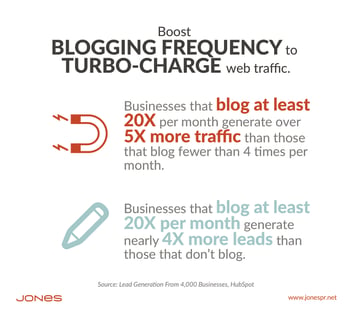4 Problems With Business Blog Plans and How to Fix Them

You’ve read all of the benefits of publishing a company blog, from improved SEO to online lead capture opportunities. So you started writing one. Sort of. Sometimes.
Chances are, if blogging was an afterthought or a random idea, you aren’t getting the kinds of results you want. That’s because successfully publishing a business blog requires planning.
Unfortunately, blogging without a plan may be worse than not blogging at all. If you aren’t taking the time to plan how to create, implement, and utilize your business blog to drive leads, you are wasting time, energy and money.
Remember to treat your blog as you would any other marketing tool and follow these 5 steps:

Fixing the four problems outlined below will ensure your business blog is an integrated part of your overall marketing strategy.
Blog Planning Problem #1:
Inconsistent publishing misses opportunities and reflects poorly on your company.
Maybe you started the blog on a whim because you had a couple of great ideas, but then other deadlines got in the way. Or post only when there is a break in other tasks, a press release to recap, or a new product announcement. If your blogging schedule can be described only as haphazard, you are missing the opportunity to establish authority and trust.
Surveys consistently show that businesses that blog more frequently and consistently generate more leads. Being inconsistent makes you seem less reliable as a source for information and solutions.
Blog Planning Solution #1:
Create a goal for publishing frequency.
Marketing platform provider HubSpot (a JONES partner) has found through surveys that businesses that blog 16-20 times per month get more than twice the traffic of those that blog 4 or fewer times per month. (Find more inbound marketing benchmarks in this report.)
Even if you can’t commit to that level of blogging, set a goal for how frequently you will publish a new blog post and stick with it, whether that is daily, weekly, or twice a month.
Tool You Can Use:
Creating a calendar for your blog will help everyone involved—writers, designers who create graphics, and marketers who are responsible for working with the blog and website—on track. Our free template provides spaces for assigning writers, planning keywords, listing target buyer personas, and designating which calls-to-action you will use in each blog post.
Blog Planning Problem #2:
Irrelevant topics don’t attract or keep readers’ attention.
When marketers don’t plan the topics they will write about, they may rely too heavily on product- and company centric content, rather than generating useful top-of-the-funnel content that provides information your potential customers are seeking. (More on finding the right blogging balance.)
Blog Planning Solution #2:
Identify keywords and topics that appeal to all of your customer personas.
More than 50 percent of all internet searchers click on the top-ranked search result, so targeting the right keywords and optimizing their use for the best possible search engine rankings is essential.
If you have been doing other types of digital marketing, you probably already know what keywords your customers are searching. Use those keywords, including specific long tail keyword phrases, in your blog posts. Blog topics should include information that appeals to each of your customer personas, with a focus on being informative and entertaining, rather than selling.
Tool You Can Use:
Mapping Content to Buyer Personas worksheet
Our Mapping Content to Buyer Personas worksheet can be used for planning individual blog posts as well as for other content marketing pieces, including ebooks, videos, case studies and worksheets. It will help you brainstorm topics that fit with each of your customer personas, determine an approach to take based on the part of the sales funnel you are targeting (awareness, consideration or decision), and outline keywords and phrases to use in the posts.
Blog Planning Problem #3:
No connection to buying cycle means the blog doesn’t generate leads or complement marketing campaigns.
A business blog is not a stand-alone entity. When it isn’t aligned with the overall marketing strategy, it can’t generate leads and feed into a lead nurturing program to qualify those leads for sales.
Blog Planning Solution #3:
Map blog posts to overall campaigns.
Connecting your business blog to the rest of your marketing strategy means ensuring that you are doing two things:
First, you are supporting other marketing efforts with related blog posts. If your social media and email marketing are all focused toward Campaign/Product/Service A, don’t fill up the blog with only posts about Campaign/Product/Service B. If a prospect comes to your website seeking information about Campaign A, make sure they are finding supporting material on your blog as well.
Secondly, remember that your blog has the potential to directly feed into your lead generation pipeline, but only if you are using calls-to-action for offers that are relevant to the blog posts. While your blog posts themselves should be largely informative and helpful in manner, it is OK—and actually imperative—that you include ways for blog readers to interact more with your website. Your CTAs in blog posts can include subtle in-text links (like the only earlier in this paragraph regarding calls-to-action), a direct contextual CTA inviting your reader to access and offer, or sidebar, header or slide-in CTAs that are more graphic and direct in nature.
When your blog content supports the current marketing campaigns, and includes CTAs to generate leads online, you can kick off a complete lead nurturing program that presents leads with relevant offers to move them through the sales funnel toward a sale.
Tool You Can Use:
Include your blog when planning out your campaigns for the year with our Campaign Planning Calendar. As you identify the content you will use to reach each stage of the sales funnel, consider the blog posts you can create to support that content and the CTAs and offers to associate with each blog post.
Blog Planning Problem #4:
Poor quality writing presents a bad image and fails to engage readers.
Blogs take time and can seem repetitive, so it is tempting to assign blog writing to your inexperienced or unskilled staffers (“It’s a great way for them to learn about the business,” you justify). But if what they create isn’t quality content, you will either spend more time rewriting their work to meet the standards you set or risk damaging your company’s image with content that is inaccurate, poorly-written, filled with company jargon or little more than another advertisement of your product or services.
Blog Planning Solution #4:
Find good writers and give them the time and tools for creating valuable content.
Find great writers and giving them the time to create great content isn’t easy. We know. Sometimes it means moving a staff person who excels in this area from another job assignment. Or it could mean looking outside your department to engage a professional writer on a freelance basis or hire an agency to supply your blog content.
A good writer should understand that effective business blog content is buyer specific, addressing the customers’ pain points, questions, challenges and decision criteria with information that helps readers solve their problems. And he or she should have a rock-solid grasp of grammar, spelling, and the style your blog uses.
Tools You Can Use:
If you want to ensure that your chosen writer understand the expectations, use our Content Quality Report Card to review what makes great inbound marketing content, including blog posts. Five criteria outlined in the report card include:
-
Quality content tells a story.
-
Quality content is useful.
-
Quality content is shareable.
-
Quality content is findable.
-
Quality content is technically sound.
If you have no choice but to turn to an inexperienced writer for your blog posts, give them a head start with our Blog Writing Templates. These templates provide a road map for five different ways to write blog posts:
-
Curated collection blog posts
-
How-to blog posts
-
List-based blog posts
-
Newsjacking blog posts
-
SlideShare presentation blog posts
A well-written business blog has the potential to be a key pillar in a multi-faceted inbound marketing program - just ask JONES client Primaris. In their first year of committing to creating inbound marketing content and blogging regularly, the company’s website traffic increased 500 percent. (Read the case study here.)
But it requires planning.
Planning, creation, and promotion are all part of the JONES approach to using a business blog to improve SEO, increase web traffic, increase leads and establish our partners as leaders—as the envy, even—in their industries. Learn more by downloading Leadership & Leads: The JONES Business Blogging Solution.
-1.png?width=1652&height=294&name=Jones(RGB)-1.png)












